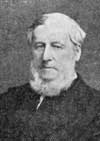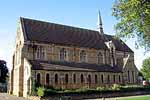For this church:    |
|
 The Rev W H The Rev W H Cantrell |
Talk of building a new church in the parish of Bulwell began in a meeting held by Christopher Wordsworth, Bishop of Lincoln, early in 1882. It was at this meeting Revd W H Cantrell, rector of Bulwell, pledged £200 towards the construction of a church in the neighbourhood known in those days as the Kiln Yards. His offer inspired generosity on the part of the people of Bulwell; a site for the church was given and many offers of money were promised.
Cantrell, known for his kindness and generosity, had earlier co-operated with Mr S T Cooper, purchaser of the Manor of Bulwell in 1865, in building the National school which is now known as St Mary’s school. Cooper died in 1871 at the early age of 39 but his widow continued his benefactions to the area. Popular for her children’s entertainments, treats to the villagers and her treatment of servants, it was to this lady that Cantrell turned for help in 1882.
The widow and her two sons divided the costs with local colliery owner, Sir Charles Seely and a bleacher, Mr G W Walker. Walker had been a churchwarden at St Mary’s for eight years and was a prominent local personality. Mr Samuel Ball donated land for the church, and Mr W Knight who had been the architect of St Andrew’s Church Mansfield Road, was invited to prepare plans.
 Foundation stone Foundation stonein the chancel |
Knight’s plans were accepted and work began at once with the foundation stone being laid on 30 October 1882. There was no written record of the events of that day but the Southwell Diocesan Magazine for June 1935 collated eyewitness testimony of the day’s events.
On 7 December 1883 an arch collapsed and the masonry came crashing to the ground. This caused a considerable delay to construction and it was not until 9 April 1885 that the church was ready for consecration.
The first Bishop of Southwell, Dr George Ridding, performed the consecration of the new church in Bulwell. The collections held at these first services amounted to £297.
Until 6 May 1928 St John’s was a chapel-of-ease to the parish church of Bulwell. On that date a new parish was formed around St John’s by Order in Council; and the Rev S M Wheeler, rector of Bulwell invited the Rev S Bradney, who had been in charge of the church since 1925, to be its first vicar.
Edwyn Hoskyns, the Bishop of Southwell, visited the church during his parochial visitation to the Deanery of Bulwell in 1913. He acknowledged the progress made ‘under conditions of great difficulty’ and also the great variety of parishes that exist in the Deanery from ‘the compact parish of Bulwell and Hucknall Torkard ... to the amorphous district of Selston or Greasley’.
In the late 1960s St John’s felt the impact of building work in Bulwell. The Rev Charles Young voiced his concerns in the Nottingham Guardian on 5 July 1969. He was recorded saying he felt ‘rather like a commander on the eve of battle’ as he prepared to challenge building developments that would negatively impact on his church.
Houses and shops were being bulldozed and the people of his parish dispersed, as major sewage works began that would last for years. The vicar called for increased parochial generosity to weather the imminent storm. The planned developments for Bulwell would grant access to the church by only one road, on the opposite side to the entrance. Mr Young campaigned vehemently and was able to force planners to incorporate a road to the north to allow access to the church from the new housing estates.
In spite of this mass upheaval in Bulwell, the Weekly Post for 20 August 1970 recorded that although ‘two thirds of the village is being pulled down ... the route to the church has been changed six times ... congregations at St John’s have not dwindled’. The Rev Mr Young successfully galvanised the support of his parishioners.
Bulwell’s community support was further put to the test under the tenure of a new vicar in the early 1970s. When the Revd Michael Hall arrived he found a decaying church at the centre of a new community of buildings. He got 25 local men together – some of who never came to church – who were prepared to take on the task of improving things. They worked evenings and weekends for nine months transforming the tumbledown vestry into a comfortable modern room and cleaning and painting the 60ft high chancel. The conversion was estimated at a cost of £5000, but the community donation of labour, materials and support saw the work come in at a mere £240. The church was renovated and modernised allowing it to maintain its position of importance in the ever-changing community it serves.






